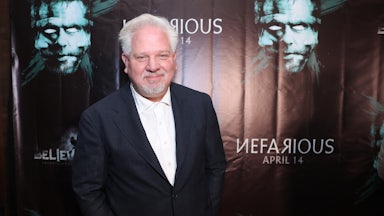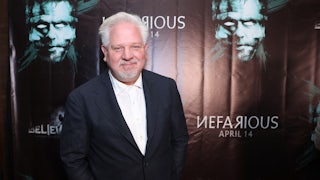At a Turning Point USA event at the University of Mississippi last week, JD Vance managed—in about a two-minute span, no less—to express disappointment in his wife, Usha, for not converting to Christianity and to call for “far less” immigration in the future. The former comments received the lion’s share of media attention, as Vance, who converted to Catholicism in 2019, said of Usha, who grew up in a Hindu household, “Do I hope eventually that she is somehow moved by the same thing that I was moved by in church? Yeah, I honestly do wish that because I believe in the Christian gospel, and I hope eventually my wife comes to see it the same way.” But the latter comments are undoubtedly more consequential for millions of people living in the United States—and many millions more who wish to do so one day.
It should surprise no one that the Trump administration has sought to reduce not just the number of undocumented immigrants coming to the United States but all types of immigration; the president and his running mate had promised as much on the campaign trail. Yet Vance’s comments at the event were remarkable not just in their nativist extremism but for the unusual historical justification he gave for his immigration position: a notably dark period in America, a full century ago, when racism and bigotry were especially rampant.
“If you go back to the 1920s,” Vance told the crowd, “the United States passed an immigration reform act that effectively cut down immigration to close to zero for 40 years in this country. And what happened over those 40 years? Many, many people who had come from many different foreign countries and different foreign cultures, they assimilated into American culture, and there was an expectation that they would assimilate into American culture.”
He went on to note that a friend from a right-wing think tank had once told him that immigration was good because diversity led to mistrust, which would prevent people from joining labor unions, the bane of corporate-friendly conservatives. Pairing the friend’s claim with his own assertion that liberals want to “flood” the country with immigrants (both legal and undocumented, one can presume), and employing the troll’s logic for which he has become known, the vice president concluded that liberals are therefore “destroying the very social trust on which American freedom and prosperity was built.” The appropriate number of immigrants to accept in the future should be “far less” than we have accepted in the past several decades, he argued, because more immigrants prevent us from becoming a “common community.”
The 1920s laws that Vance touted as a boon to American society imposed strict immigration quotas based on national origin. They targeted Southern and Eastern Europeans and Jews in particular for exclusion, since they were seen as inferior by the still-popular eugenicist movement, which perceived Italians as lazy and unhygienic and Jews as naturally conniving. Asians were already barred by previous laws, and the 1920s acts made it clear that they were still not welcome—a policy that would not change until the Johnson administration in the 1960s. Mexicans, however, still needed for labor purposes, were classified by the federal government as “white,” even if they remained second-class citizens for all other purposes, allowing them to come in and work in factories and on farms.
What Vance doesn’t seem to realize—or conveniently ignores—is that the 1920s acts that led to these curtailments were advocated by the resurgent Ku Klux Klan, which hated not only Blacks and Jews but Vance’s own group, Catholics, with almost as much vitriol. The second KKK took root in 1915 after it was glamorized in the film Birth of a Nation, and continued to grow during and after World War I, when the first Red Scare led U.S. citizens to fear they were being undermined by Bolsheviks and saboteurs. During Prohibition, the Klan capitalized on anti-Catholic sentiment among temperance groups, positioning itself as an extra-governmental enforcer of the law. “Prohibition provided the Klan essentially a kind of new mandate for its anti-Catholic, anti-immigrant, white Protestant nationalist mission,” Lisa McGirr, a professor of history at Harvard, told History.com.
This sentiment helped to fuel the 1920s laws that Vance is now praising. The KKK, which grew to perhaps as many as five million members strong at its peak in the 1920s—in a nation with just about 120 million people—was enormously influential in getting the anti-immigration laws passed. In fact, Imperial Wizard Hiram Wesley Evans wrote in a 1926 paper that “the restriction of immigration” was one of the KKK’s proudest achievements over the previous decade. To Evans, this was as much an anti-Catholic crusade as anything: “Most immigration of recent years, so unassimilable and fundamentally un-American, has been Catholic.”
Ironically, Vance is applying the same logic to keeping out immigrants today, particularly those from Latin American or predominantly Muslim countries. As The Bulwark reported, he stated in 2022 that “our capacity to assimilate the next generation of immigrants is limited, and our legal immigration system should account for this fact by changing who we let in and reducing the total numbers.” He reiterated this sentiment in 2024 when he said, “What we want is an American immigration policy that promotes assimilation.” Speaking about Muslim immigrants on Joe Rogan’s podcast, he offered this bigoted assessment, after Rogan suggested we may fall under sharia law: “Real religious tyranny is increasingly in Western societies where you’ve had a large influx of immigrants who don’t necessarily assimilate into Western values but try to create, I think, a religious tyranny at the local level. And if you think that won’t happen at the national level, you’re crazy.”
In his paper, Evans similarly averred that aliens from abroad—in his case, the Catholics—were taking advantage of us, stating that the KKK was “against any attempt to use the privileges and opportunities which aliens hold only through our generosity as levers to force us to change our civilization, to wrest from us control of our own country.” In other words, he didn’t want the Catholics to turn us all into pope worshippers or to impose their religious standards on our laws.
In fact, it’s remarkable how much Evans and Vance sound alike, despite a century’s separation. Just as Vance denies that his position has anything to do with the color of certain immigrants’ skin or their religion, Evans declared, “We deny that either bigotry or prejudice enters into our intolerance or our narrowness.” Instead, like Vance, he positioned himself as a defender of American ideals. His 1926 paper’s very title is “The Klan’s Fight for Americanism.” “Except for a few lonesome voices, almost drowned by the clamor of the alien and the alien-minded ‘Liberal,’ the Klan alone faces the invader,” he wrote.
Vance blames liberals for the “flood” of immigrants that has supposedly swept America. “I think it’s the most disgraceful thing that Kamala Harris has done this cycle,” he said last year, “is not just flood this country with cheap labor and people who are competing with you for homes, but to then tell you that you’re a bad person for daring to speak up and to have a voice about what’s going on in your own country.” He hit a similar theme on the same day that he appeared at Turning Point. In an interview with conservative podcaster and Trump sycophant Miranda Devine, he posed a situation wherein an American family is evicted from their home in favor of immigrants: “And then 20 people move into a three-bedroom house. Twenty people from a totally different culture, totally different ways of interacting.… Their next-door neighbors are gonna say, ‘Well, wait a second. What is going on here? I don’t know these people. They don’t speak the same language that I do.’ And because there are twenty in the house next door, it’s a little bit rowdier than it was when there was just a family of four or a family of five. It is totally reasonable and acceptable for American citizens to look at their next-door neighbors and say, ‘I wanna live next to people who I have something in common with. I don’t want to live next to four families of strangers.”
They’re strangers because they’re not “real Americans,” one can suppose. Real Americans are white and speak English—and ideally carry a gun and love Donald Trump. If that doesn’t describe you, then you have an inkling of what it felt like to be a Catholic in the 1920s.








